Assessing Overheating Risks in Moderately Insulated Irish Social Housing: Analysis of Building Energy Ratings and Indoor Temperature Profiles
Abstract
1. Introduction
1.1. Policy Relevance of Research
1.2. Aim of the Study
- Evaluate the indoor temperature profiles of a large number of social housing units in Ireland to assess overheating risks during the summer months.
- Assess the impact of different overheating criteria, namely: Static criteria Guide A and the Passivhaus Institute standard, along with adaptive criteria CIBSE TM59.
2. Literature Review
2.1. Criteria of Overheating Analysis
3. Methodology
3.1. Data Collection
3.2. Indoor Temperature Pattern
3.3. Outdoor Temperature Pattern
3.4. Assessment of Overheating Risk
3.4.1. Static Criteria: CIBSE Guide A and Passivhaus Institute
3.4.2. Adaptive Criteria: CIBSE TM59
4. Results
4.1. BER Rating of All Dwellings in the Sample Set
4.2. Indoor Temperature Pattern
4.3. Correlations Between Indoor Temperature and BER
4.4. Outdoor Temperature Pattern
4.5. Evaluation of Overheating Risk
Evaluation of Overheating Risk Based on Static Criteria and Adaptive Criteria
5. Discussion
Limitation and Furthur Work
- ○
- The data set, while larger than many, still only covers a group or segment of the Irish building stock. More research should be conducted on similarly rated homes in other parts of the country.
- ○
- Although there was an intention to assess the overheating risk in bedrooms, upon filtering and review of the data, the sample size was deemed too small to make any significant conclusion. We therefore propose that this be assessed in future work.
- ○
- The data used were not from sensors installed by the authors of this study. Access was provided by the local council. As with all data of this kind, there are risks that some of the data points could be misleading. Given the size of the dataset and following the filtering process, we believe it is large enough to accommodate those potential issues.
- ○
- The static methods are a crude assessment of overheating. We acknowledge this but nonetheless found the results interesting and worthy of sharing.
- ○
- Ireland has a mild temperate climate and is not expected to experience overheating risks to the same extent as other parts of the world, particularly in moderately insulated homes. Nonetheless, this study contributes by giving a degree of confidence to designers that the risk of overheating in moderately insulated homes in mild temperate climates is likely negligible.
- ○
- Future work will assess retrofitting strategies (e.g., shading systems, insulation level, MVHR system, and replacement windows) to mitigate overheating risks in homes.
- ○
- Future investigations will focus on modern, efficient air conditioning systems with a short payback period and long service life.
- ○
- Furthermore, future studies should monitor some factors, alongside variables, to determine the exact causes of exceedance hours and the risk of overheating in dwellings such as building characteristics, including location, orientation, construction materials, floor area, ventilation strategies, and window configurations.
6. Conclusions
Author Contributions
Funding
Data Availability Statement
Acknowledgments
Conflicts of Interest
Abbreviations
| BER | Building Energy Ratings |
| Cfb | Temperate Oceanic Climate |
| CIBSE | Chartered Institution of Building Services Engineers |
| DEAP | Dwelling Energy Assessment Procedure |
| DLR | Dun Laoghaire Rathdown |
| EEA | European Environment Agency |
| HSE | National Health Sustainability Office |
| IEA | International Energy Agency |
| IEA-EBC | International Energy Agency’s Energy in Buildings and Communities |
| IPCC | Intergovernmental Panel on Climate Change |
| MVHR | Mechanical Ventilation with Heat Recovery |
| nZEBs | nearly Zero Energy Buildings |
| PHPP | Passive House Planning Package |
| REHVA | Federation of European Heating, Ventilation and Air Conditioning Associations |
| UKCP | UK Climate Programmed |
| WHO | World Health Organization |
References
- Amengual, A.; Homar, V.; Romero, R.; Brooks, H.E.; Ramis, C.; Gordaliza, M.; Alonso, S. Projections of heat waves with high impact on human health in Europe. Glob. Planet. Change 2014, 119, 71–84. [Google Scholar] [CrossRef]
- Basu, R.; Samet, J.M. Relation between elevated ambient temperature and mortality: A review of the epidemiologic evidence. Epidemiol. Rev. 2002, 24, 190–202. [Google Scholar] [CrossRef] [PubMed]
- EEA. Number of Extreme Heat Waves in Future Climates Under Two Different Climate Forcing Scenarios. 2019. Available online: https://www.eea.europa.eu/data-and-maps/figures/number-of-extreme-heat-waves-1 (accessed on 2 July 2023).
- Eurostat. Excess Mortality-Statistics. 2023. Available online: https://ec.europa.eu/eurostat/statistics-explained/index.php?title=Excess_mortality_-_statistics (accessed on 2 July 2023).
- IPCC. The Intergovernmental Panel on Climate Change. 2023. Available online: https://www.ipcc.ch (accessed on 20 March 2023).
- Attia, S.; Benzidane, C.; Rahif, R.; Amaripadath, D.; Hamdy, M.; Holzer, P.; Koch, A.; Maas, A.; Moosberger, S.; Petersen, S. Overheating calculation methods, criteria, and indicators in European regulation for residential buildings. Energy Build. 2023, 292, 113170. [Google Scholar] [CrossRef]
- Poortinga, W.; Whitmarsh, L.; Steg, L.; Böhm, G.; Fisher, S. Climate change perceptions and their individual-level determinants: A cross-European analysis. Glob. Environ. Change 2019, 55, 25–35. [Google Scholar] [CrossRef]
- O’Hegarty, R.; Kinnane, O. Whole life carbon quantification of the built environment: Case study Ireland. Build. Environ. 2022, 226, 109730. [Google Scholar] [CrossRef]
- Climate-Adapt. Tropical Nights, 2011–2099. 2023. Available online: https://climate-adapt.eea.europa.eu/en/metadata/indicators/tropical-nights-2011-2099 (accessed on 2 July 2023).
- McLeod, R.S.; Hopfe, C.J.; Kwan, A. An investigation into future performance and overheating risks in Passivhaus dwellings. Build. Environ. 2013, 70, 189–209. [Google Scholar] [CrossRef]
- Tham, Y.; Muneer, T.; Levermore, G.; Chow, D. An examination of UKCIP02 and UKCP09 solar radiation data sets for the UK climate related to their use in building design. Build. Serv. Eng. Res. Technol. 2011, 32, 207–228. [Google Scholar] [CrossRef]
- Gupta, R.; Gregg, M.; Irving, R. Meta-analysis of summertime indoor temperatures in new-build, retrofitted, and existing UK dwellings. Sci. Technol. Built Environ. 2019, 25, 1212–1225. [Google Scholar] [CrossRef]
- De Carli, M.; Bernardi, A.; Cultrera, M.; Dalla Santa, G.; Di Bella, A.; Emmi, G.; Galgaro, A.; Graci, S.; Mendrinos, D.; Mezzasalma, G. A database for climatic conditions around Europe for promoting GSHP solutions. Geosciences 2018, 8, 71. [Google Scholar] [CrossRef]
- Rubel, F.; Kottek, M. Observed and projected climate shifts 1901–2100 depicted by world maps of the Köppen-Geiger climate classification. Meteorol. Z. 2010, 19, 135. [Google Scholar] [CrossRef]
- Finegan, E. An Empirical Investigation into Current and Future Overheating Frequency in nZEB and Passivhaus Dwellings in Ireland. Ph.D. Thesis, Munster Technological University, Cork, Ireland, 2022. [Google Scholar]
- Lomas, K.J.; Porritt, S.M. Overheating in Buildings: Lessons from Research; Taylor & Francis: Abingdon, UK, 2017; Volume 45, pp. 1–18. [Google Scholar]
- Santamouris, M.; Kolokotsa, D. On the impact of urban overheating and extreme climatic conditions on housing, energy, comfort and environmental quality of vulnerable population in Europe. Energy Build. 2015, 98, 125–133. [Google Scholar] [CrossRef]
- Alrasheed, M.; Mourshed, M. Domestic overheating risks and mitigation strategies: The state-of-the-art and directions for future research. Indoor Built Environ. 2023, 32, 1057–1077. [Google Scholar] [CrossRef]
- Attia, S.; Eleftheriou, P.; Xeni, F.; Morlot, R.; Ménézo, C.; Kostopoulos, V.; Betsi, M.; Kalaitzoglou, I.; Pagliano, L.; Cellura, M. Overview and future challenges of nearly zero energy buildings (nZEB) design in Southern Europe. Energy Build. 2017, 155, 439–458. [Google Scholar] [CrossRef]
- Attia, S.; Shadmanfar, N.; Ricci, F. Developing two benchmark models for nearly zero energy schools. Appl. Energy 2020, 263, 114614. [Google Scholar] [CrossRef]
- Attia, S.; Kurnitski, J.; Kosiński, P.; Borodiņecs, A.; Belafi, Z.D.; István, K.; Krstić, H.; Moldovan, M.; Visa, I.; Mihailov, N. Overview and future challenges of nearly zero-energy building (nZEB) design in Eastern Europe. Energy Build. 2022, 267, 112165. [Google Scholar] [CrossRef]
- McGill, G.; Sharpe, T.; Robertson, L.; Gupta, R.; Mawditt, I. Meta-analysis of indoor temperatures in new-build housing. Build. Res. Inf. 2017, 45, 19–39. [Google Scholar] [CrossRef]
- REHVA COVID-19 Guidance Document. 2020. Available online: https://www.rehva.eu/fileadmin/user_upload/REHVA_COVID-19_guidance_document_V3_03082020.pdf (accessed on 3 August 2020).
- Jensen, S.Ø.; Marszal-Pomianowska, A.; Lollini, R.; Pasut, W.; Knotzer, A.; Engelmann, P.; Stafford, A.; Reynders, G. IEA EBC annex 67 energy flexible buildings. Energy Build. 2017, 155, 25–34. [Google Scholar] [CrossRef]
- Psomas, T.; Heiselberg, P.; Duer, K.; Bjørn, E. Overheating risk barriers to energy renovations of single family houses: Multicriteria analysis and assessment. Energy Build. 2016, 117, 138–148. [Google Scholar] [CrossRef]
- Davies, F.N.; Sadique, M.; Amoako-Attah, J. Investigating effective building fabric as a passive cooling technique to combat overheating in UK residential buildings. Eng. Future Sustain. 2023, 1, 1–17. [Google Scholar] [CrossRef]
- Mourkos, K.; McLeod, R.S.; Hopfe, C.J.; Goodier, C.; Swainson, M. Assessing the application and limitations of a standardised overheating risk-assessment methodology in a real-world context. Build. Environ. 2020, 181, 107070. [Google Scholar] [CrossRef]
- Mitchell, R.; Natarajan, S. Overheating risk in Passivhaus dwellings. Build. Serv. Eng. Res. Technol. 2019, 40, 446–469. [Google Scholar] [CrossRef]
- Figueiredo, A.; Kämpf, J.; Vicente, R. Passive house optimization for Portugal: Overheating evaluation and energy performance. Energy Build. 2016, 118, 181–196. [Google Scholar] [CrossRef]
- Morgan, C.; Foster, J.; Poston, A.; Sharpe, T. Overheating in Scotland: Contributing factors in occupied homes. Build. Res. Inf. 2017, 45, 143–156. [Google Scholar] [CrossRef]
- Toledo, L.; Wright, A.; Cropper, P. Case study investigation of overheating in low-energy homes: Insights from a post-occupancy evaluation in England. Build. Res. Inf. 2024, 53, 139–164. [Google Scholar] [CrossRef]
- Zahiri, S.; Gupta, R. Examining the Risk of Summertime Overheating in UK Social Housing Dwellings Retrofitted with Heat Pumps. Atmosphere 2023, 14, 1617. [Google Scholar] [CrossRef]
- Finegan, E.; Kelly, G.; O’Sullivan, G. Comparative analysis of Passivhaus simulated and measured overheating frequency in a typical dwelling in Ireland. Build. Res. Inf. 2020, 48, 681–699. [Google Scholar] [CrossRef]
- Mulville, M.; Stravoravdis, S. The impact of regulations on overheating risk in dwellings. In Building Governance and Climate Change; Routledge: London, UK, 2019; pp. 47–61. [Google Scholar]
- IEA, Energy in Building and Communities Program (EBC), Annex 80—Resilient Cooling of Buildings, Completed (2018–2024). Available online: https://annex80.iea-ebc.org/#:~:text=The%20Annex%2080’s%20main%20objective,and%20overheating%20issues%20in%20buildings (accessed on 11 May 2024).
- Hamdy, M.; Carlucci, S.; Hoes, P.-J.; Hensen, J.L. The impact of climate change on the overheating risk in dwellings—A Dutch case study. Build. Environ. 2017, 122, 307–323. [Google Scholar] [CrossRef]
- Attia, S. Spatial and behavioral thermal adaptation in net zero energy buildings: An exploratory investigation. Sustainability 2020, 12, 7961. [Google Scholar] [CrossRef]
- Guide, A. Environmental Design. Chartered Institute of Building Services Engineers (CIBSE). 2006. Available online: https://aioucheats.com/AIOU%20Assignments%20Papers%20Spring%202011/Postgraduate/1588.doc (accessed on 15 January 2006).
- CIBSE. CIBSE Guide A: Environmental Design; The Chartered Institution of Building Services Engineers: London, UK, 2015; Updated 2021; Available online: https://www.cibse.org/knowledge-research/knowledge-portal/guide-a-environmental-design-2015 (accessed on 22 July 2015).
- Passive House Institute. Passive House Requirements; Passive House Institute: Darmstadt, Germany, 2015. [Google Scholar]
- Bonfigli, C.; Chorafa, M.; Diamond, S.; Eliades, C.; Mylona, A.; Taylor, B.; Virk, D. TM59: Design Methodology for the Assessment of Overheating Risk in Homes; CIBSE: London, UK, 2017. [Google Scholar]
- CIBSE. TM59 Design Methodology for the Assessment of Overheating Risk in Homes, Dr Anastasia Mylona, CIBSE Research Manager, London Climate Change Partnership—Heat Risk in London Group. 19 September 2017. Available online: https://climatelondon.org/wp-content/uploads/2017/11/CIBSE-TM59-for-web.pdf (accessed on 19 September 2017).
- CIBSE. TM52 The Limits of Thermal Comfort: Avoiding Overheating in European Buildings, Chartered Institute of Building Services Engineers. 2013. Available online: https://www.cibse.org/knowledge-research/knowledge-portal/tm52-the-limits-of-thermal-comfort-avoiding-overheating-in-european-buildings (accessed on 10 October 2013).
- BS EN 16798-1:2019; Energy Performance of Buildings-Ventilation for Buildings, Part 1: Indoor Environmental Input Parameters for Design and Assessment of Energy Performance of Buildings Addressing Indoor Air Quality, Thermal Environment, Lighting and Acoustics-Module M1-6. British Standards Institution: London, UK, 2019.
- PD CEN/TR 16798-2; Energy Performance of Buildings-Ventilation for Buildings, Part 2: Interpretation of the Requirements in EN 16798-1—Indoor Environmental Input Parameters for Design and Assessment of Energy Performance of Buildings Addressing Indoor Air Quality, Thermal Environment, Lighting and Acoustics (Module M1-6)-Module M1-6. British Standards Institution: London, UK, 2019. Available online: https://webstore.ansi.org/standards/bsi/pdcentr167982019?srsltid=AfmBOorGM_789feD8A2LRx3ozeyqF5bbO9O0D4oLCDs92r72KZWQTF6q (accessed on 9 May 2019).
- BS EN 15251; Indoor Environmental Input Parameters for Design and Assessment of Energy Performance of Buildings Addressing Indoor Air Quality, Thermal Environment Lighting and Acoustics. British Standards Institution: Brussels, Belgium, 2007. Available online: https://www.thenbs.com/PublicationIndex/documents/details?Pub=BSI&DocId=286992 (accessed on 31 July 2008).
- Zhao, B.; Zhao, Y.; Xu, Y.; Yu, J.; Yin, X.; Chang, W.S.; Guo, H. Refining adaptive models for overheating evaluation: Evidence-driven comparative analysis of residential buildings in China’s cold and severe cold regions. Build. Environ. 2024, 263, 111896. [Google Scholar] [CrossRef]
- Li, P.; Parkinson, T.; Schiavon, S.; Froese, T.M.; de Dear, R.; Rysanek, A.; Staub-French, S. Improved long-term thermal comfort indices for continuous monitoring. Energy Build. 2020, 224, 110270. [Google Scholar] [CrossRef]
- European Parliament, Directive. 2002/91/EC of the European Parliament and of the Council of 16 December 2002 on the Energy Performance of Buildings. 2002. Available online: https://eur-lex.europa.eu/eli/dir/2002/91/oj/eng (accessed on 16 December 2002).
- IPCC. Synthesis Report of the IPCC Fifth Assessment Report (AR5); Pachauri, R.K., Meyer, L.A., Eds.; IPCC: Geneva, Switzerland, 2014; 151p. [Google Scholar]
- Adak, S.; Mandal, N.; Mukhopadhyay, A.; Maity, P.P.; Sen, S. Current State and Prediction of Future Global Climate Change and Variability in Terms of CO2 Levels and Temperature. In Enhancing Resilience of Dryland Agriculture Under Changing Climate: Interdisciplinary and Convergence Approaches; Springer: Berlin/Heidelberg, Germany, 2023; pp. 15–43. [Google Scholar]
- Nicol, J.F.; Hacker, J.; Spires, B.; Davies, H. Suggestion for new approach to overheating diagnostics. Build. Res. Inf. 2009, 37, 348–357. [Google Scholar] [CrossRef]
- Schiermeier, Q. The real holes in climate science: Like any other field, research on climate change has some fundamental gaps, although not the ones typically claimed by sceptics. Quirin Schiermeier takes a hard look at some of the biggest problem areas. Nature 2010, 463, 284–288. [Google Scholar] [CrossRef] [PubMed]
- Jang, J.; Natarajan, S.; Lee, J.; Leigh, S.-B. Comparative analysis of overheating risk for typical dwellings and Passivhaus in the UK. Energies 2022, 15, 3829. [Google Scholar] [CrossRef]
- Kumar, P.; Wright, B.; Petsou, A. Overheating in Historic Buildings in the UK: An Exploratory Study of Overheating Risks, Building Performance, and Thermal Comfort. Heritage 2024, 7, 4829–4854. [Google Scholar] [CrossRef]
- Chen, S.; Zhao, H.; Luo, K.; Li, Q.; Nie, Z.; Zhao, L. Health risk assessment of residential overheating under the heat waves in Guangzhou. Build. Environ. 2024, 266, 112089. [Google Scholar] [CrossRef]
- Anderson, M.; Carmichael, C.; Murray, V.; Dengel, A.; Swainson, M. Defining indoor heat thresholds for health in the UK. Perspect. Public Health 2013, 133, 158–164. [Google Scholar] [CrossRef]
- Head, K.; Clarke, M.; Bailey, M.; Livinski, A.; Ludolph, R.; Singh, A. Web Annex D: Report of the Systematic Review on the Effect of Indoor Heat on Health; World Health Organization: Geneva, Switzerland, 2018. [Google Scholar]
- World Health Organization. WHO Housing and Health Guidelines; World Health Organization: Geneva, Switzerland, 2018. [Google Scholar]
- HSE Sustainability Office. Available online: https://www.hse.ie/eng/about/who/healthbusinessservices/national-health-sustainability-office/ (accessed on 7 March 2023).
- Fujii, H.; Fukuda, S.; Narumi, D.; Ihara, T.; Watanabe, Y. Fatigue and sleep under large summer temperature differences. Environ. Res. 2015, 138, 17–21. [Google Scholar] [CrossRef]
- Lan, L.; Lian, Z. Ten questions concerning thermal environment and sleep quality. Build. Environ. 2016, 99, 252–259. [Google Scholar] [CrossRef]
- Climote Smart Technology. Available online: https://www.climote.ie/heating/ (accessed on 1 September 2015).
- Sajadirad, F.; O’Hegarty, R.; Kinnane, O. Analysis Overheating in Irish houses: Result from a large sample set. In Proceedings of the 8th International ICARB Conference 2023, Edinburgh, UK, 30 June 2023; Available online: https://www.researchgate.net/publication/388557657_Analysis_Overheating_in_Irish_houses_Result_from_a_large_sample_set (accessed on 30 June 2023).
- Goncalves, V.L.; Costanzo, V.; Fabbri, K.; Rakha, T. Overheating assessment in Passivhaus dwellings: The influence of prediction tools. Build. Cities 2022, 3, 153–167. [Google Scholar] [CrossRef]
- Farrokhirad, E.; Gao, Y.; Pitts, A.; Chen, G. A Systematic Review on the Risk of Overheating in Passive Houses. Buildings 2024, 14, 2501. [Google Scholar] [CrossRef]
- Sadeghi, M.; Chen, D.; Wright, A. A Critical Review of Overheating Risk Assessment Criteria in International and National Regulations—Gaps and Suggestions for Improvements. Energies 2024, 17, 6354. [Google Scholar] [CrossRef]
- Lomas, K.; Watson, S.; Allinson, D.; Fateh, A.; Beaumont, A.; Allen, J.; Foster, H.; Garrett, H. Dwelling and household characteristics’ influence on reported and measured summertime overheating: A glimpse of a mild climate in the 2050’s. Build. Environ. 2021, 201, 107986. [Google Scholar] [CrossRef]
- Lee, D.-S.; Jo, J.-H. Measuring and implementing mean radiant temperature in buildings: Technical review. Renew. Sustain. Energy Rev. 2025, 207, 114908. [Google Scholar] [CrossRef]
- Alfano, F.R.d.A.; Pepe, D.; Riccio, G.; Vio, M.; Palella, B.I. On the effects of the mean radiant temperature evaluation in the assessment of thermal comfort by dynamic energy simulation tools. Build. Environ. 2023, 236, 110254. [Google Scholar] [CrossRef]
- Raushan, K.; Mac Uidhir, T.; Salvador, M.L.; Norton, B.; Ahern, C. Filtered dataset of Irish energy performance certificates: A data-driven approach for enhanced building stock modelling. Data Brief 2025, 59, 111281. [Google Scholar] [CrossRef]
- Colclough, S.; Kinnane, O.; Hewitt, N.; Griffiths, P. Investigation of nZEB social housing built to the Passive House standard. Energy Build. 2018, 179, 344–359. [Google Scholar] [CrossRef]
- Coggins, A.M.; Wemken, N.; Mishra, A.K.; Sharkey, M.; Horgan, L.; Cowie, H.; Bourdin, E.; McIntyre, B. Indoor air quality, thermal comfort and ventilation in deep energy retrofitted Irish dwellings. Build. Environ. 2022, 219, 109236. [Google Scholar] [CrossRef]
- Morey, J.; Beizaee, A.; Wright, A. An investigation into overheating in social housing dwellings in central England. Build. Environ. 2020, 176, 106814. [Google Scholar] [CrossRef]
- Drury, P. The Summertime Overheating Signature of UK Homes. Ph.D. Thesis, Loughborough University, Loughborough, England, 2024. [Google Scholar]
- Sajadirad, F.; O’Hegarty, R.; Kinnane, O. Incidence of Overheating in Irish Homes for the Range of Building Energy Rated Dwellings. Available online: https://www.researchgate.net/publication/388559679 (accessed on 28 May 2024).

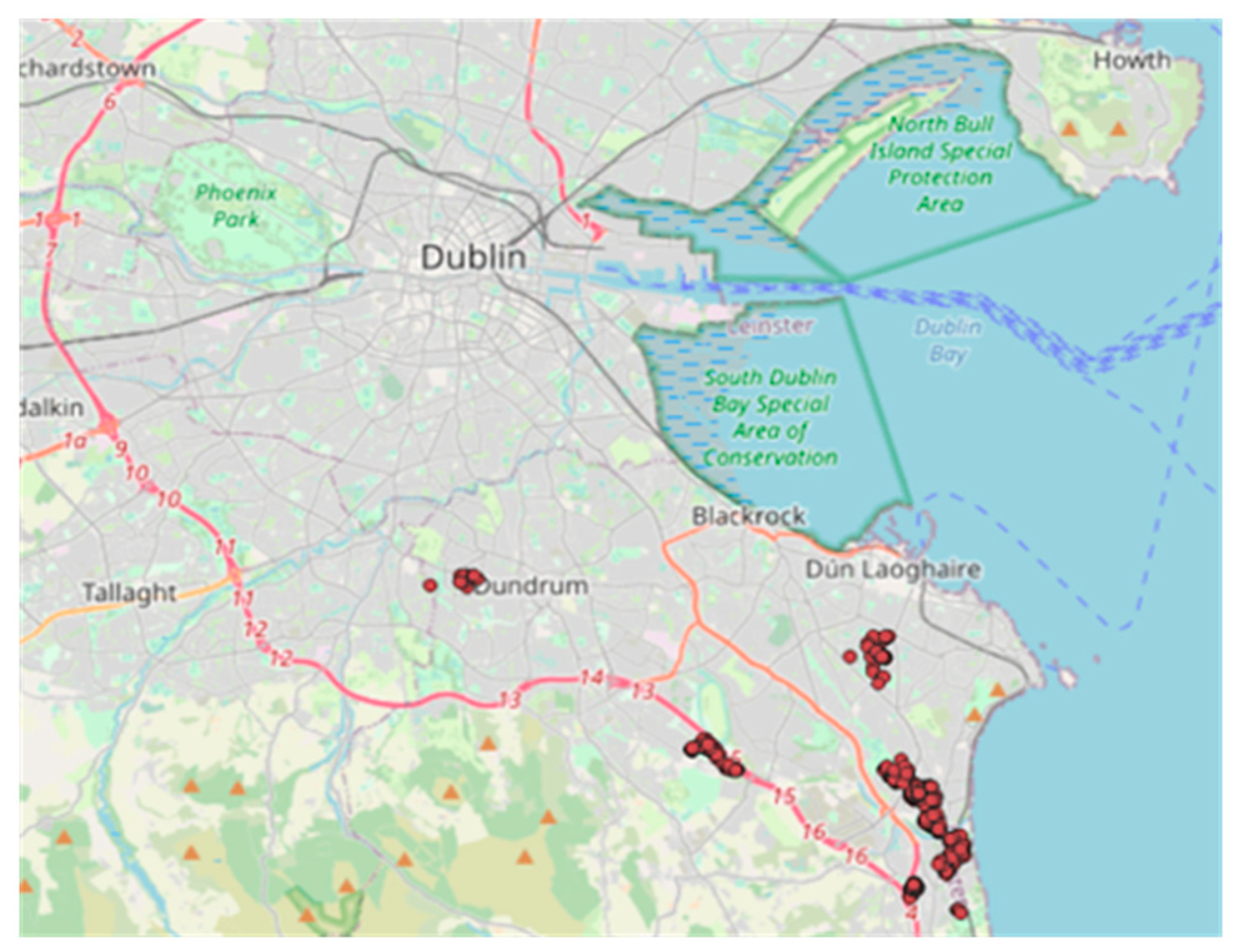
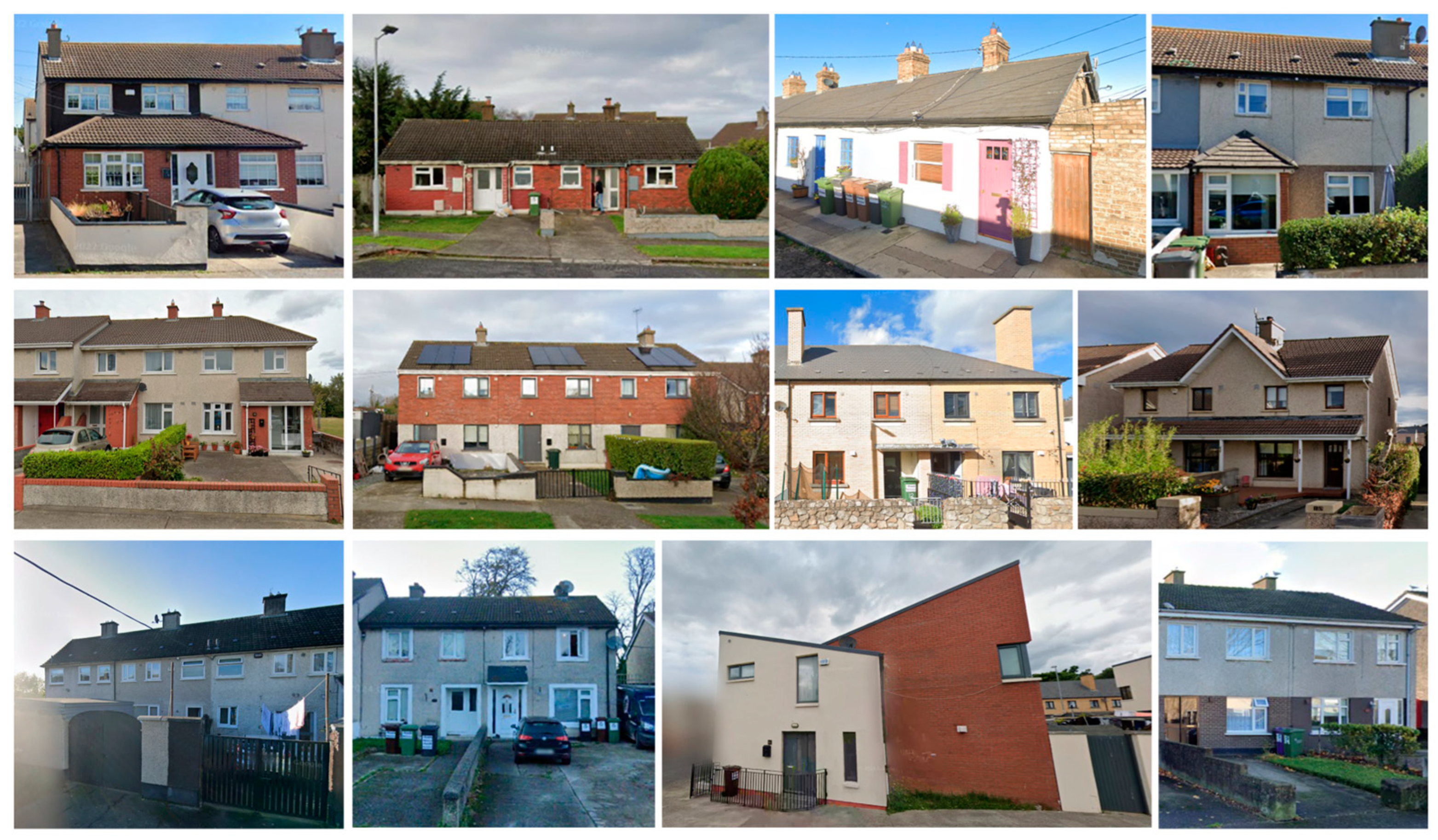
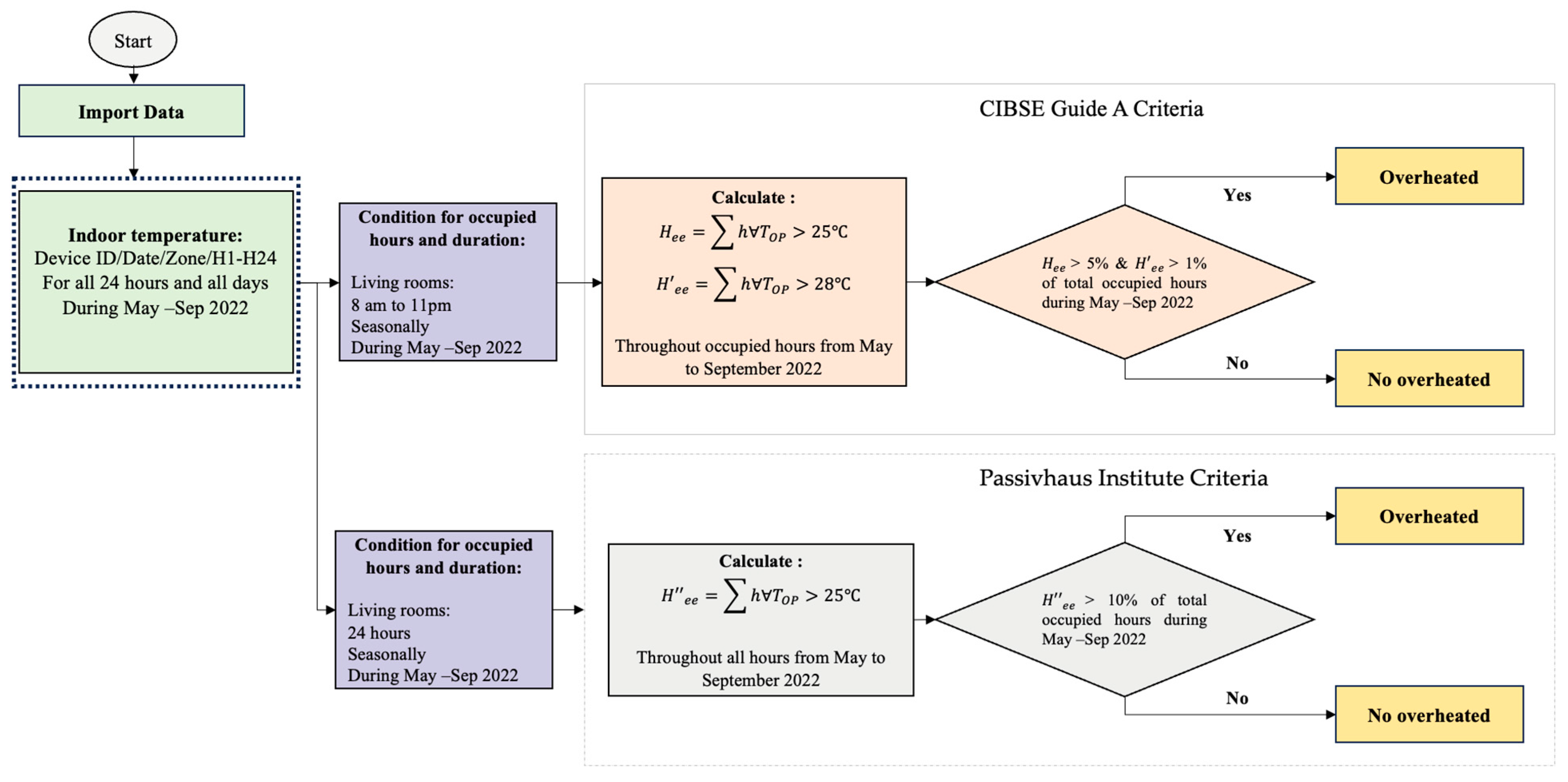

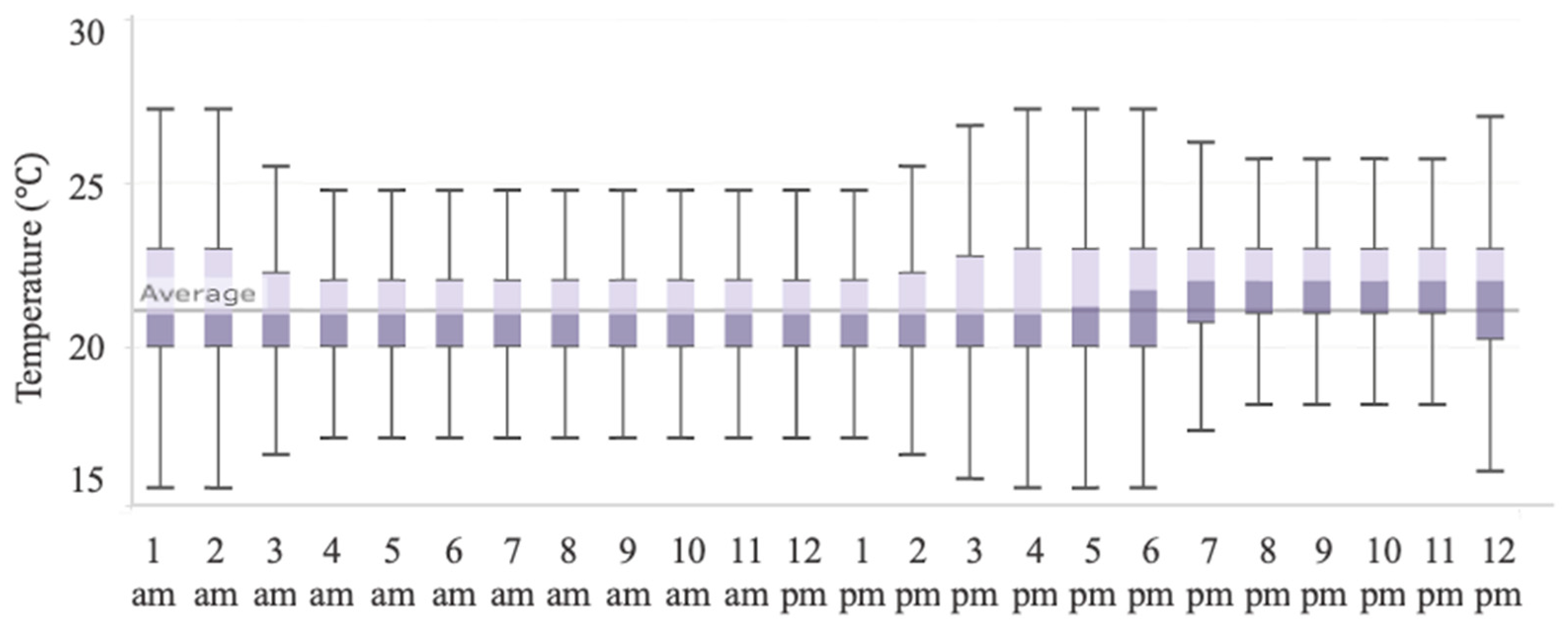
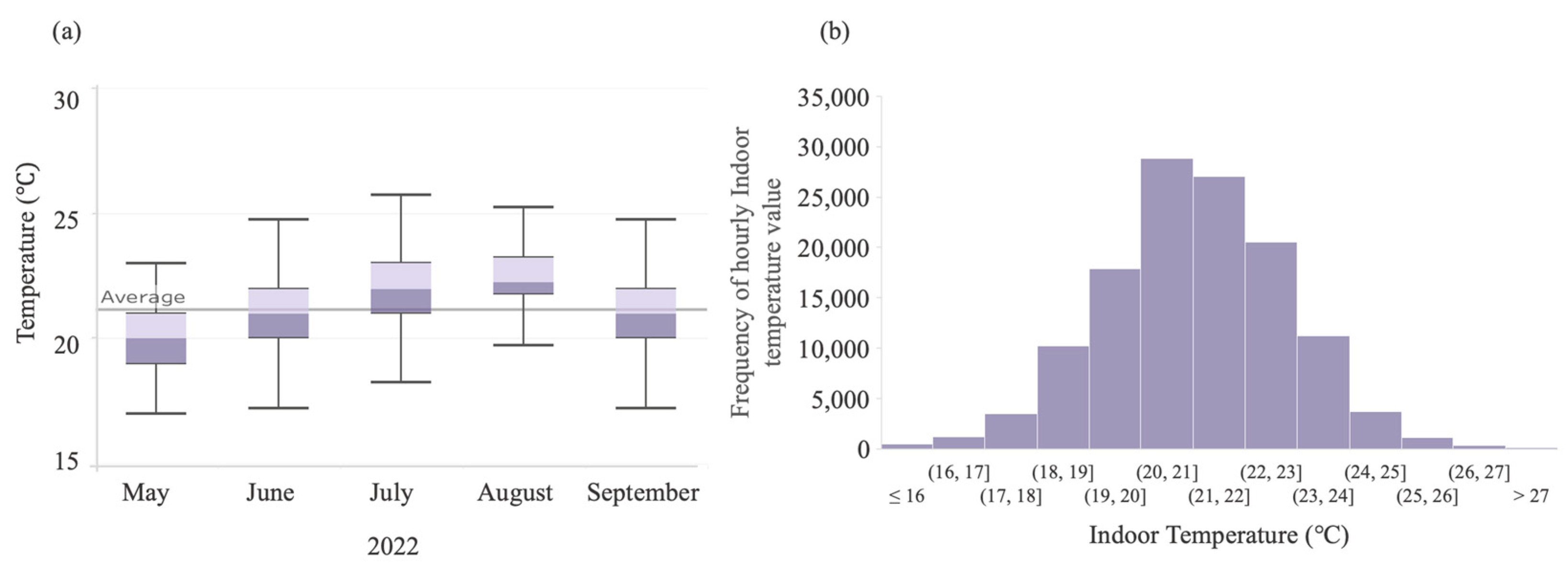

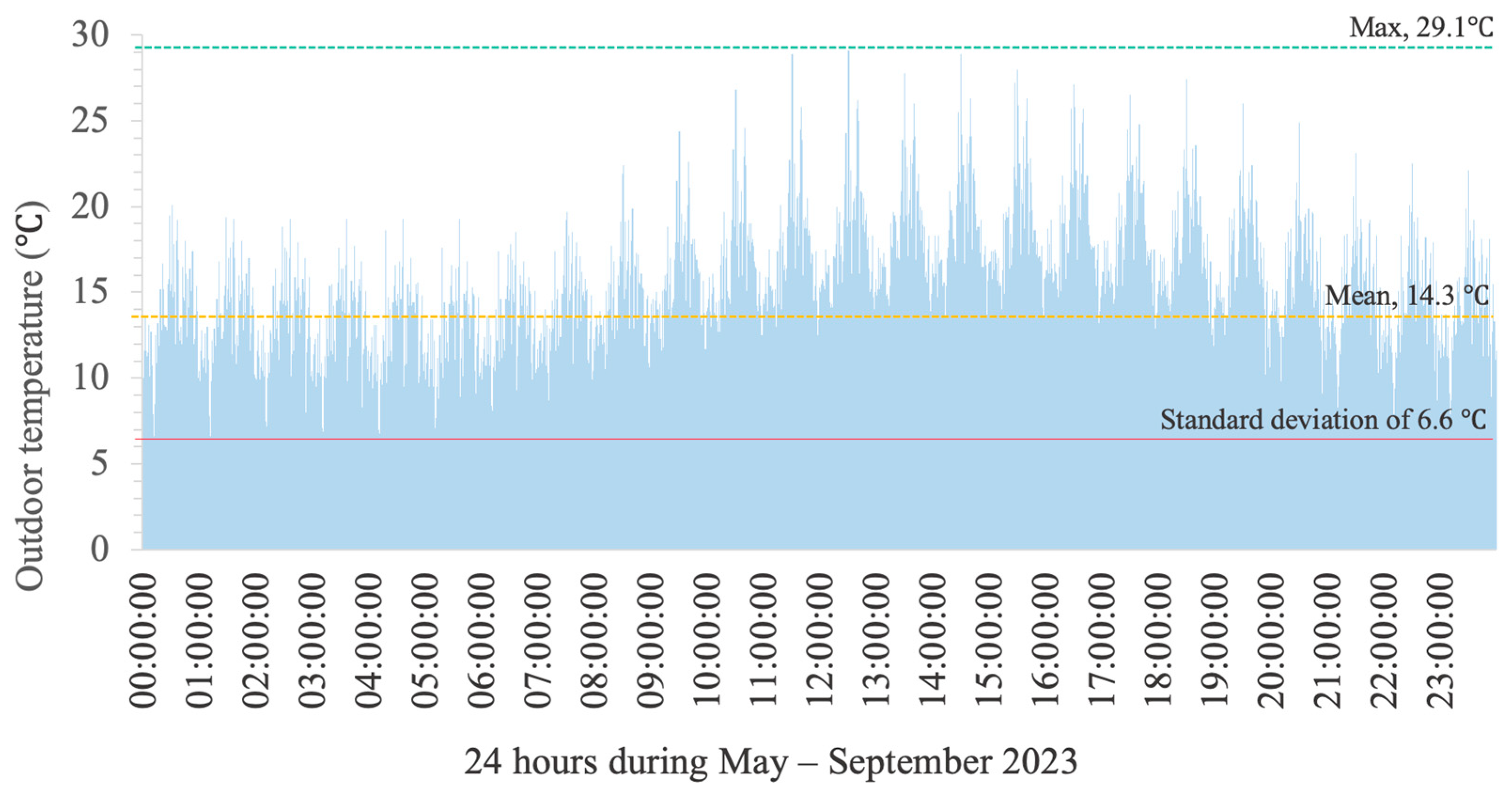

| Sample Set BER | Irish BER Database | |||||
|---|---|---|---|---|---|---|
| no | BER | Number | Percentage (%) | BER | Number | Percentage (%) |
| 1 | A | 1 | <1 | A | 44,638 | 6 |
| 2 | B | 27 | 3 | B | 115,566 | 15 |
| 3 | C | 383 | 41 | C | 314,831 | 40 |
| 4 | D | 102 | 11 | D | 170,619 | 22 |
| 5 | E | 41 | 4 | E | 74,980 | 9 |
| 6 | F | 11 | 1 | F | 32,182 | 4 |
| 7 | G | 3 | <1 | G | 37,573 | 5 |
| 8 | No code listed | 375 | 40 | |||
| Total | 943 | 100 | 790,389 | 100 | ||
Disclaimer/Publisher’s Note: The statements, opinions and data contained in all publications are solely those of the individual author(s) and contributor(s) and not of MDPI and/or the editor(s). MDPI and/or the editor(s) disclaim responsibility for any injury to people or property resulting from any ideas, methods, instructions or products referred to in the content. |
© 2025 by the authors. Licensee MDPI, Basel, Switzerland. This article is an open access article distributed under the terms and conditions of the Creative Commons Attribution (CC BY) license (https://creativecommons.org/licenses/by/4.0/).
Share and Cite
Sajadirad, F.; O’Hegarty, R.; Kinnane, O. Assessing Overheating Risks in Moderately Insulated Irish Social Housing: Analysis of Building Energy Ratings and Indoor Temperature Profiles. Energies 2025, 18, 1381. https://doi.org/10.3390/en18061381
Sajadirad F, O’Hegarty R, Kinnane O. Assessing Overheating Risks in Moderately Insulated Irish Social Housing: Analysis of Building Energy Ratings and Indoor Temperature Profiles. Energies. 2025; 18(6):1381. https://doi.org/10.3390/en18061381
Chicago/Turabian StyleSajadirad, Fahimehsadat, Richard O’Hegarty, and Oliver Kinnane. 2025. "Assessing Overheating Risks in Moderately Insulated Irish Social Housing: Analysis of Building Energy Ratings and Indoor Temperature Profiles" Energies 18, no. 6: 1381. https://doi.org/10.3390/en18061381
APA StyleSajadirad, F., O’Hegarty, R., & Kinnane, O. (2025). Assessing Overheating Risks in Moderately Insulated Irish Social Housing: Analysis of Building Energy Ratings and Indoor Temperature Profiles. Energies, 18(6), 1381. https://doi.org/10.3390/en18061381








